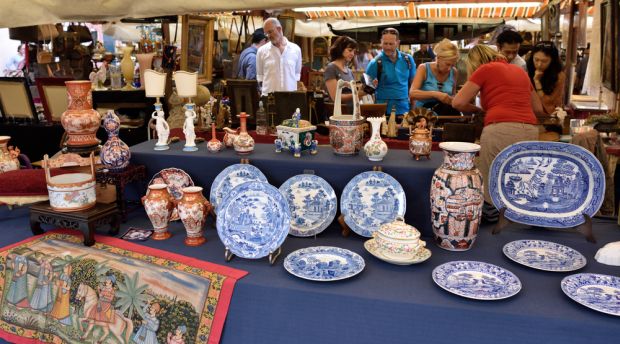Artist Careers: How to Have a Career as an Artist
Post Views 2“If you’re lucky, you’ll spend most of your time alone and working,” wrote one twenty-year veteran painter. Trying to express a specific and unique vision through painting, sculpture, drawing, or mixed media characterizes the artist’s life. While many spend time in workshops, attending other artists’ shows and seminars, and doing research, the heart of the matter–the reason why people choose to join the unremunerative and very selective fine arts–is because they love what they do. As a purely self-expressing career, 90 percent of artists make, on average, under $1,000 per annum on their art. The financial rewards come to few, and generally later in life. The work itself and the supportive community make this financially uncertain lifestyle worthwhile.
The frustration that can accompany this profession is significant. Unscrupulous gallery owners and untrustworthy agents can make an artist’s life difficult, to say the least. Most artists use their specific set of marketable tools as freelance commercial artists, producing work on consignment to another’s specifications, to pay the rent. Some note that this ‘selling’ of their skills at times affects their ability to produce their own work. “It’s hard to paint my own pictures when I’m sketching a box of oats all day,” said one. But a commercial artist can earn as much as $40,000 per year in part-time work. Many artists return to school to learn the possibilities of computer and computer-enhanced art. This is only one of the ways in which artists engage themselves with the frontiers of their world. It is this openness to the world at large, the many changes that take place in it, and the multiple possibilities which it offers that, in the end, is the hallmark of the profession of artist.
Paying Your Dues to Become an Artist
History is rife with examples of self-schooled artists with no formal educational training who are both brilliant and innovative; unfortunately, history is also rife with examples of starving artists, dying in obscurity. Formal educational training in this field is becoming the norm, with most earning BFAs in graphic design, painting, or art history. Some find it helpful to continue their education and earn graduate degrees (primarily MFAs), particularly if they desire to teach painting at the secondary level or above. Many academic programs provide at least an introduction to computer-assisted art. Artists tend to congregate around major urban centers, such as New York and San Francisco, where the multiplicity of galleries and artists makes it easier to form working connections and for an unproven artist to get shown.
Associated Careers to Being an Artist
Artists have a number of opportunities available to them, both during their careers as artists and after they’ve decided to hang up their brushes. Many work as commercial artists, computer artists, and electronic layout consultants using their aesthetic and representational skills in higher-paying professions. Some become art directors for magazines, on-line services, software companies, publishing houses and manufacturers. Others move into advertising, promotion and product design.
Past And Future of an Artist Career
Art has been practiced for ages, as evidenced, for instance, by the animal drawings discovered in caves in Lascaux, France, which date back to 30,000 B.C. Portraiture has a long European history as an honored profession, and one of the greatest supporters of the arts through the ages has been the Catholic Church (also, at times, one of the most strident critics). Commercial art, as a separate industry, arose with the advent of the modern advertising industry, and produces over 75 percent of all art available for view in the United States in every year.
The methods and mediums of art may change, but the intention has remained the same: To reinvent, to communicate in a new and fascinating way. In the future, the role that art plays will not change drastically, but painting, photography, sketching, sculpting, metalworking, and many other historically used mediums will be joined by computer art, mixed-media art and other emerging forms that will reflect the ages from which they emerge. The real danger to the prospective artist lies in the future of funding for the arts, both individually and societal. The National Endowment for the Arts faces drastic slashing of funds; tax proposals may eliminate the tax advantages of private contributions; universities are reducing art staffs. Patrons, dealers and collectors may exert an even greater influence over the life of the artist. Some degree of support for the arts will always continue–the level, however, is uncertain.
Quality of Life
Two Years Out
Most artists spend their first few years learning their craft and making connections. Many seek other employment, as these early years are marked by little or no income from their own art. Hours are long, but many say that in these early years, the long hour is more spent on examining other people’s art, making introductions to dealers and critics, and networking through the art community rather than producing their own work. Many take classes, join workshops, and use this time to explore their craft.
Five Years Out
Many five-year survivors have had their art shown and reviewed and made significant connections in the art world. A number of those who have received some good reviews are now sponsored by dealers, galleries or agents. They continue to work at their craft and concentrate on producing art. Most artists at this point have found consistent ways to pay the rent.
Ten Years Out
For those who have lasted ten years and received little praise, remember that there is no fixed timeline for progression as an artist. The sense of frustration, however, is significant for those who haven’t received much positive encouragement. Those who remain may experience ‘second life blues,’ where initial success has been tempered by the difficulty of following up and reinventing. Those with good connections and excellent reputations may find themselves gaining academic, teaching, or colony credentials. A number of artists at this age apply for and receive grants from the NEA and other funding sources. While ten years is a significant milestone in a number of professions, as an artist, timing is nothing; continuing and evolving is everything.
Professional Profile
| # of people in profession | 1,610,000 |
| % male: | 60 |
| % female: | 40 |
| average hours per week: | 50 |
Professionals Read
Art News
Airbrush Magazine
American Art Review
Art Forum
Books, Films and TV Shows Featuring the Profession
My Left Foot
Vincent and Theo
Turner
The Agony and the Ecstasy
Major Employers
| Guggenheim Museum 1071 5th Ave. New York, NY 10128 Tel: 212-423-3600 Fax: 212-423-3650 Contact: Personnel |
Seattle Museum of Art P.O. Box 2300 Seattle, WA 98122 Tel: 206-625-8900 Fax: 206-654-3135 Contact: Human Resources |
Metropolitan Museum of Art 1000 5th Ave. 82nd St. New York, NY 10028 Tel: 212-535-7710 |
You’ll Have Contact With
Art Dealers
Agents
Advertising Executives
Product Designers
Curators
Major Associations
| American Design and Drafting Association PO Box 799 Rockville, MD 20848-0799 Tel: 301-460-6875 |
American Institute of Graphic Arts 1059 Third Avenue New York, NY 10021 Tel: 212-807-1990 Fax: 212-807-1799 Contact: Publication Department |
New York Artists Equity Association 498 Broome Street New York, NY 10013 Tel: 212-941-0130 |



 7 Jobs for People Who Want to Work in Tech but Aren’t an Engineer
7 Jobs for People Who Want to Work in Tech but Aren’t an Engineer  Profiles of People Who Work At Home
Profiles of People Who Work At Home  What Are the Different Types of Internships?
What Are the Different Types of Internships?  Jobs That Allow You to Work Remotely
Jobs That Allow You to Work Remotely  How to Ace a Dental Hygienist Interview
How to Ace a Dental Hygienist Interview  How to Get a Job on a Cruise Ship: What it is Like Working on a Cruise Ship
How to Get a Job on a Cruise Ship: What it is Like Working on a Cruise Ship  Becoming an Art Dealer: What it is Like Having a Career as an Art Dealer
Becoming an Art Dealer: What it is Like Having a Career as an Art Dealer  What Does a Medical Laboratory Technician Do?
What Does a Medical Laboratory Technician Do?